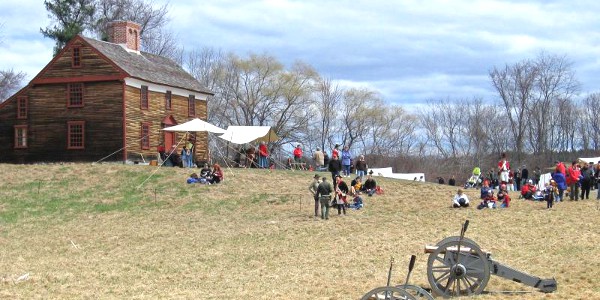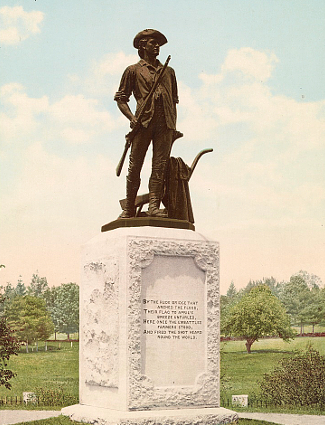
Above image: Statue of the Minute Man, Concord, 1900, Detroit Publishing Company. Right: Image of the Battle of Lexington, Amos Doolittle. Date unknown, late 1700s, early 1800s. Images: Library of Congress.
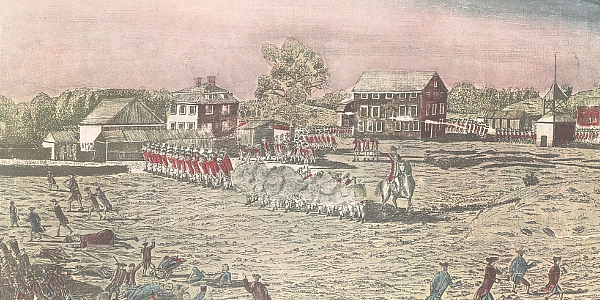
Minute Man National Historic Park
It had been prompted by a Tea Party in Boston only twenty miles away and pushed by the fractious bullwhips of a British rule that no longer could be tolerated. And more British were coming to make sure an uprising being fomented behind closed doors would be crushed. And yes, Paul Revere would ride between the towns of Lexington, Concord, and Boston to warn his fellow citizens of the incoming troops. And battles would be fought at Lexington and Concord to cement the idea that the colonists would not be quelled. Today, you can visit this site and walk the paths trod by Paul Revere and fought for by those minute men. Today, you can buy tea without British import taxes and freely speak about the rule of the land. Hoorah to those Minute Men for making that possible.
Click here to Sponsor the page and how to reserve your ad.
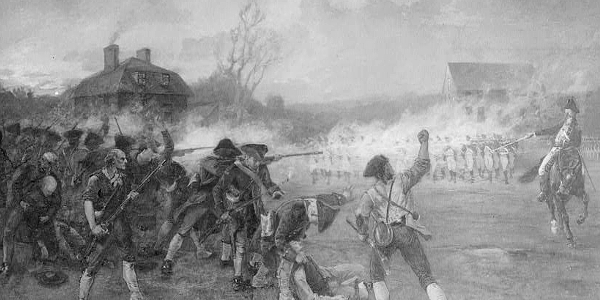
Minute Man Then
It had been a year and one half since the Boston Tea Party and the British Government was not relenting. They passed Coercive Laws with penalties meant to recover the loss from that tea, they dissolved the semi-self rule Colonial Government and replaced it with a Governor, Thomas Gage, the Royal Governor, who would rule with strict interpretation. When additional British regular troops started to threaten a growing insurrection as the year of 1775 began, the Minute Men trained, in essence to protect the territory from French and Indians, but in actuality, to train to gain their freedom. It was a controversial tact, one not all agreed on, perhaps, all the way up to the time the first shots rang out at Concord's North Bridge and British blood was shed. After that, there was no doubt. A revolution had begun.
Minute Man Dates/Times of Importance
April 18, 1775 (9-10 p.m.) - Joseph Warren tells Paul Revere and William Dawes to ride to Lexington and warn leaders and militia that the British were mobilizing toward them.
April 18, 1775 (10 p.m. to 1:00 a.m.) - Revere, Dawes, Samuel Prescott, and up to forty men ride throughout the countryside between Boston and Concord, warning of the British approaching. Revere is eventually caught, but released without his horse.
April 19, 1775 (Dawn) - Battle of Lexington Green, outside National Park boundaries in town of Lexington. First action.
April 19, 1775 (11:00 a.m.) - Battle of Concord, North Bridge. First time colonists fired back and killed British regulars with Emerson's famous line "shot heard round the world" immortalizing the fight.
April 19, 1775 (Afternoon to Evening) - British regulars retreat toward Boston, engaging up to 2,000 militia in irregular skirmishes at locations like Brooks Hill and the Bloody Angle. By the next morning, up to 15,000 militia had surrounded Boston amd the American Revolution had begun.
Minute Man History - In many respects, it was the British government's fault that the men of the Massachusetts colony and the other colonies along the eastern seaboard were ready and able to fight as the dates of the revolution approached. All men from sixteen to sixty in Massachusetts had to belong to a militia in order to fight the enemies of the British; i.e. the French and the Indians. See French and Indian war only fifteen years before for the reason why. When loyalists were purged from the commanders of the militia by the Massachusetts Provincial Congress, and a portion of the militia segregated into new special companies, the Minute Men were born. They would be paid. They would train frequently. They would keep their arms by their side and be ready in a minute. When Paul Revere rode to explain that the British were coming to Concord and Lexington, they were ready in that minute.
How big were these towns in 1770s versus today? Not large. Boston, the big city, had only 15,500 people in 1765, the last census prior to the American Revolution. Lexington had 941 people in 1790.
Photo above: Another image of the Battle of Lexington. Source: Library of Congress. Below: Minute Man reenactors at Minute Man National Historic Park. Source: National Park Service.

Minute Man Now
The park moves like a ribbon of homes and historic sites along the Battle Road and the main roads from Lexington to Concord. It tells the story of the beginnings of the American Revolution with tales of the ride of Paul Revere, William Dawes, and Samuel Prescott, plus others, who warned of the coming British storm, and the mobilization of thousands of men with revolution ties who would thwart them, in small skirmish battles, then surround them in Boston one day later. There are eleven witness homes in and around the park. Two visitor centers are located at each end; the main Minute Man Visitor Center in the east, and the North Bridge Visitor Center in the west. Ranger tours, the Road to Revolution film, and walks along the Battle Road give visitors a chance to recreate the times of these men who fought for freedom.
T-Shirts and Souvenirs

Minute Man American Revolution History T-Shirts and Souvenirs from the official souvenirs of americasbesthistory.com.

Minute Man
Things You Should Not Miss
1. It's time to take a Ranger tour here. They cover a variety of topics and will really get you in tune with the occurences of Paul Revere and those April 19, 1775 battles. There are tours at the Hartwell Tavern, North Bridge, and Whittemore House. Pick a couple and get your revolution on.
2. Walk the Battle Road. Whether you're on your own or with a tour, it's a treat to follow in the footsteps of the soldiers who fought for your freedom. Five miles long from Concord to Lexington, you'll pass so much history, by the end, you might just qualifty for historian status, if you're paying attention to the homes and waysides between the Minute Man Visitor Center (actually a bit east at the Fiske House site) through Parker's Revenge, the Paul Revere capture site, Smith House area, the Bloody Angle, and Merriam's Corner (actually not all the way to Concord).
3. Make sure you watch the Minute Man Visitor Center audio-visual program, the Road to Revolution. Probably a good thing to do first.
Photo above: Soldiers of the Continental Army lithograph by Henry Alexander Ogden, 1897. Courtesy Library of Congress.
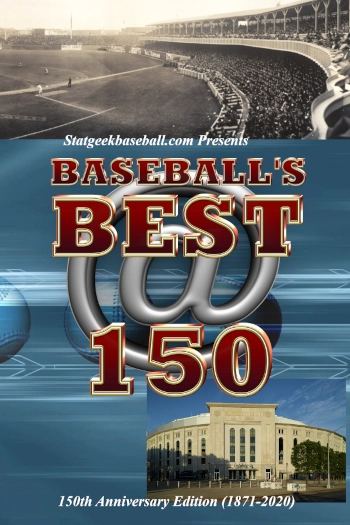
Get Baseball History and Books at Stat Geek Baseball, including Baseball's Best @ 150, the book that counts down 8,000 of the best batters, pitchers, and fielders of all your favorite teams, including the Boston Red Sox, New York Yankees, and more for the 1st 150 years of Major League Baseball (1871-2020).

